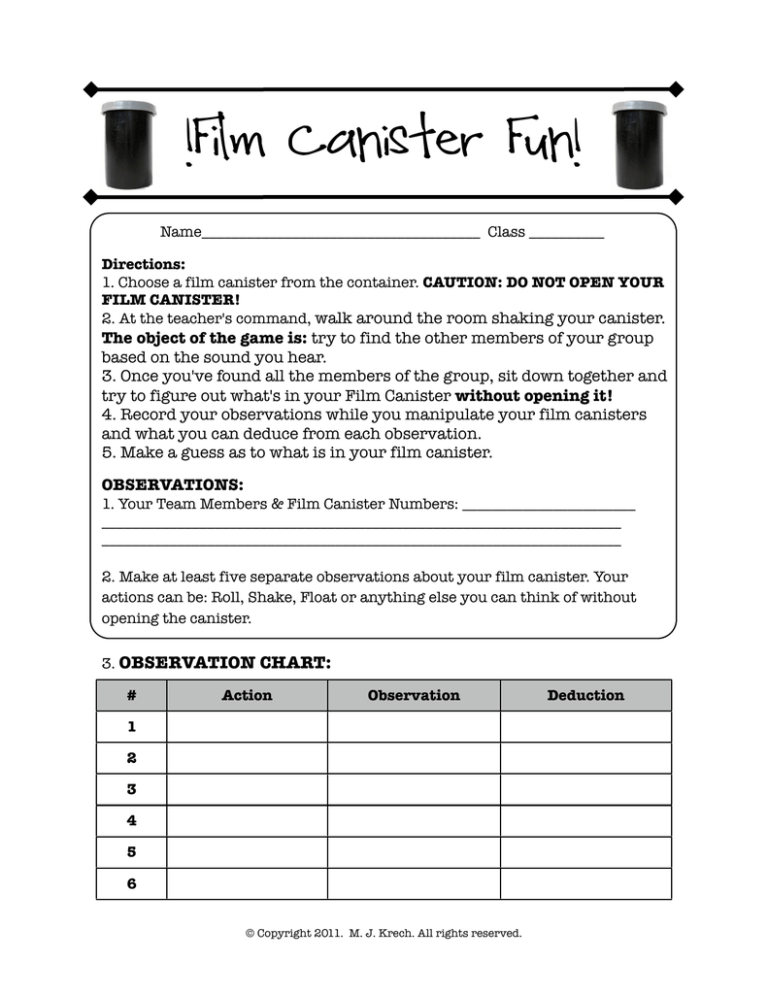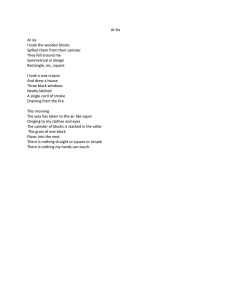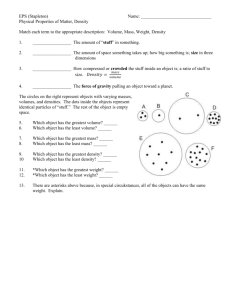
!Film Canister Fun!
Name_____________________________________ Class __________
Directions:
1. Choose a film canister from the container. CAUTION: DO NOT OPEN YOUR
FILM CANISTER!
2. At the teacher's command, walk around the room shaking your canister.
The object of the game is: try to find the other members of your group
based on the sound you hear.
3. Once you've found all the members of the group, sit down together and
try to figure out what's in your Film Canister without opening it!
4. Record your observations while you manipulate your film canisters
and what you can deduce from each observation.
5. Make a guess as to what is in your film canister.
OBSERVATIONS:
1. Your Team Members & Film Canister Numbers: _______________________
_____________________________________________________________________
_____________________________________________________________________
2. Make at least five separate observations about your film canister. Your
actions can be: Roll, Shake, Float or anything else you can think of without
opening the canister.
3. OBSERVATION CHART:
#
Action
Observation
1
2
3
4
5
6
© Copyright 2011. M. J. Krech. All rights reserved.
Deduction
4. Make a list of at least five things you and your team think could be inside
your film canisters:
a.
b.
c.
d.
e.
5. Which of the five things listed above do you and your team think is most
likely inside your film canisters? (You must all agree!)
_________________________________________________________________________
6. What is the main reason for your choice?
7. Was there anyone in your group who disagree with the team choice for #6?
Why?
8. Was there anyone in any of the teams that seemed to be in the wrong group?
How did they figure it out? Did they find their team eventually? How?
9. Were you right?
Why do you know or not know?
How does this apply to the "real world?"
© Copyright 2011. M. J. Krech. All rights reserved.
Based on: Film Canister Fun
Originally submitted by Judi Flaherty, Quincy, MA
From: http://sciencespot.net/Pages/classgen.html#Anchor-filmcan
I learned the following activity at a Museum of Science camp-in and have used it dozens of
times in many different venues from Physical Science class to ice breakers in Youth Group.
Use the film canisters to divide the kids into groups or teams or with same materials have
them work in teams to study the scientific method or deductive reasoning.
If you have 30 kids and want 5 groups of 6, you will need 30 film canisters (all alike). Put
them in rows of 6, with caps off and fill each row with something different, such as rice,
pennies, marble, popcorn, paper clips, water, karo syrup, magnet, push pin, eraser, etc. You'll
have 6 canisters with rice in them, and 6 with paper clips, etc. Put the lids on the canisters
and put them all in a bag. Have the kids each pick one and then move about the room shaking
the canister and trying to find the other members of their group based on the sound they hear.
Once in the group they can try floating, rolling, shaking, etc. to come up with a hypothesis
for the contents or deduce the contents based on non-visible evidence. It's quite fun, has
endless combinations and possibilities, and the kids really get in to it.
Marcia's Notes:
This activity can be used to mirror scientific observation and discovery
in the "real world." To that end, I would strongly suggest you number
each canister, NOT in sequence, of course, and keep track of each group
of six canisters. (If anyone gets in the wrong group, you would have a
better chance of helping them their group.
Also, at the end, have each group go up to the board and record their
numbers and what they think they have inside. Then go up and circle
only those groups who are right. DON'T TELL ANY GROUP WHO IS
WRONG WHAT THEY REALLY HAVE! This is how it works in the "real
world." We don't know if we are right or wrong, nobody can tell us, we
just have to keep experimenting until we are sure.
Then I would suggest you collect the film canisters before anyone gets
really desperate and opens their can. Of course, you could always seal
them with glue or tape.
© Copyright 2011. M. J. Krech. All rights reserved.


